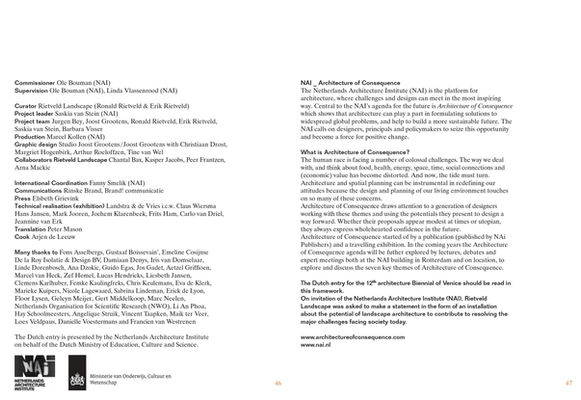
Vacant NL
2010
As part of the comprehensive NAi Architecture of Consequence agenda, Rietveld Landscape was invited to design the presentation in the Dutch pavilion at the 2010 Venice Architecture Biennale, entitled Vacant NL. The 1954 pavilion having been vacant for most of its existence was itself one of the thousands of unoccupied buildings on Dutch soil, many of them of high architectural quality. The installation, set against the backdrop’ of a severe global financial crisis, proposed to make use of the enormous potential of inspiring, unoccupied buildings to foster innovation within the creative knowledge economy. Inside the empty pavilion, there was a mysterious installation; a landscape of thousands of empty buildings, cut out of blue foam. The Dutch Atlas of Vacancy, designed by Joost Grootens, highlighted the potential of all those buildings via the first concrete proposals.
Introduction
old architecture as currency for a new spirit
It sounds so obvious that it almost passes unnoticed, but the theme of this architecture biennale marks a turning point in its history. After more than thirty years of mainly asking the public to look at architecture, this time the focus is on something that the rest of the world has known about for a long time: that architecture is in the first place intended as a place to meet. Kazuyo Sejima has turned architecture into a verb: a good building makes something happen that goes beyond the building itself. What the building itself wants to say, is of secondary importance. This biennale tones down the importance of the architectural expression in order to give increased prominence to the architectural performance. At the same time it makes architecture extremely relevant again, because if there is anything that this profession needs at the present time, it is the proof that it matters not only in the Arsenale and the Giardini, but also in the everyday lives of people – in fact, that it can enhance the quality of those lives.
We can call this shift from individual expression to collective performance the Architecture of Consequence. The NAI launched its innovation agenda at the end of 2008 in which the terrains are determined on which this performance can be made very substantial. Architecture was presented that formulates answers in an improbably creative way to the existential questions that challenge us all over the world. It is an architecture that is no longer a social liability by the choices that it makes of the wrong materials and building techniques, the wrong way to climatize environments, the wrong locations, the wrong investment horizons, and by producing outdated typologies, but is a social benefactor by making the right choice on all those fronts. Architecture was also shown that helps people to meet one another in a way that promotes increasing mutual acceptance. To put it mildly, there is plenty of need for that at the moment.
















































